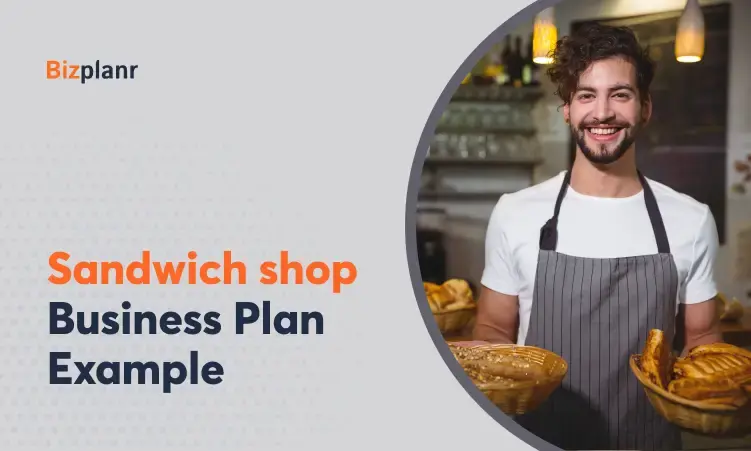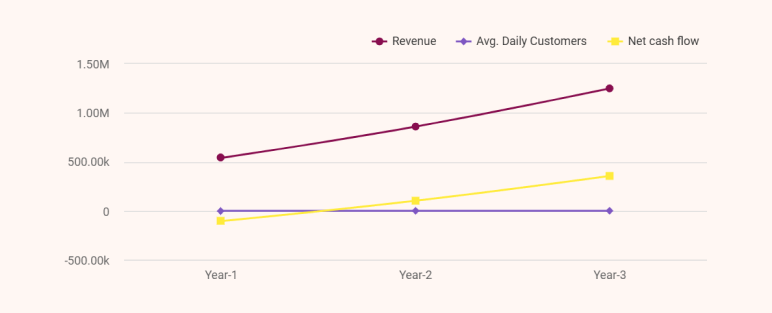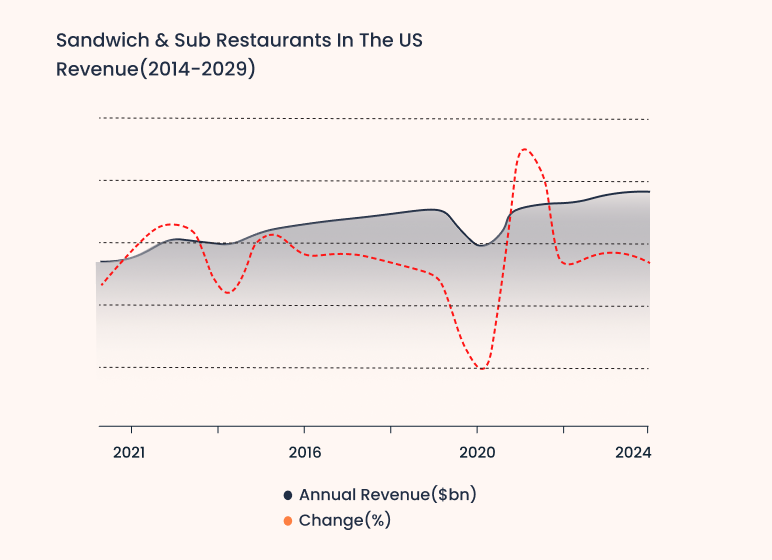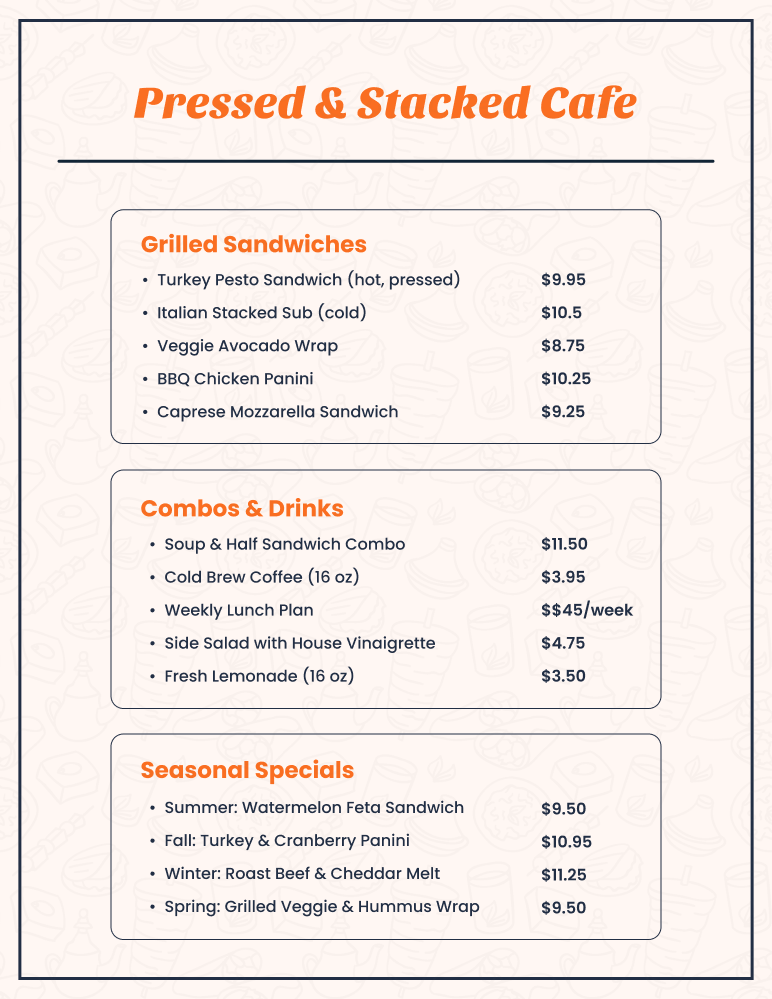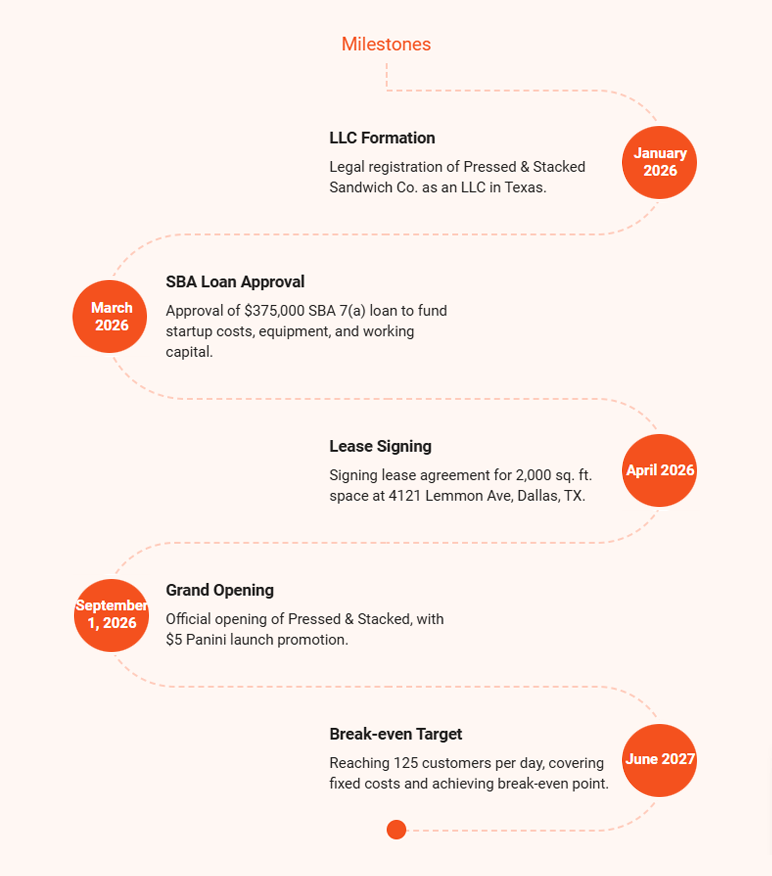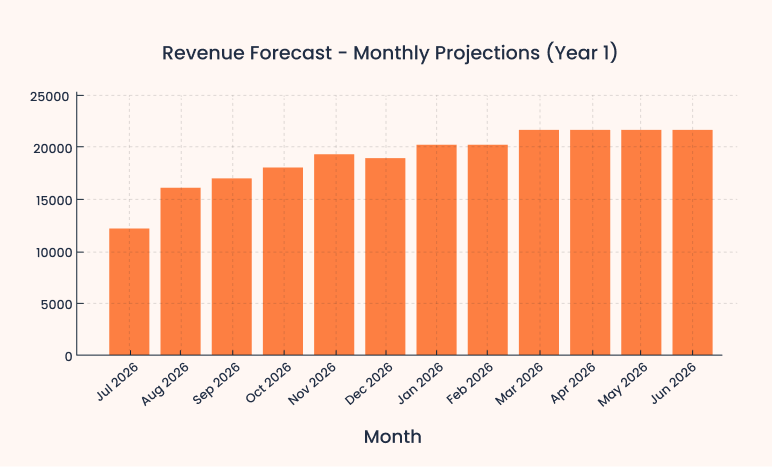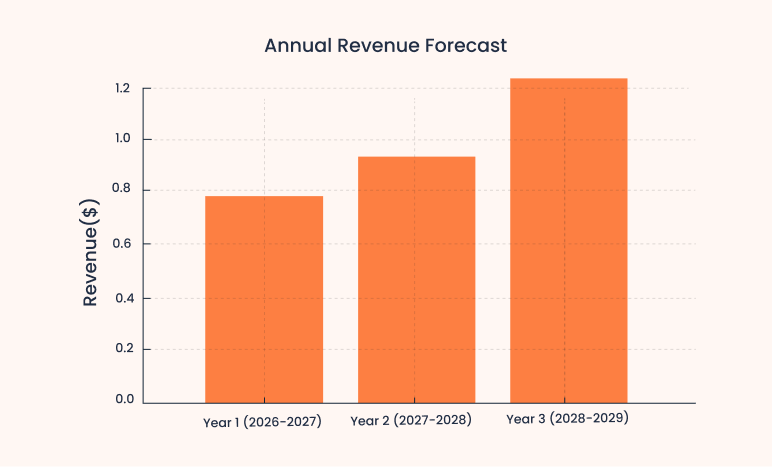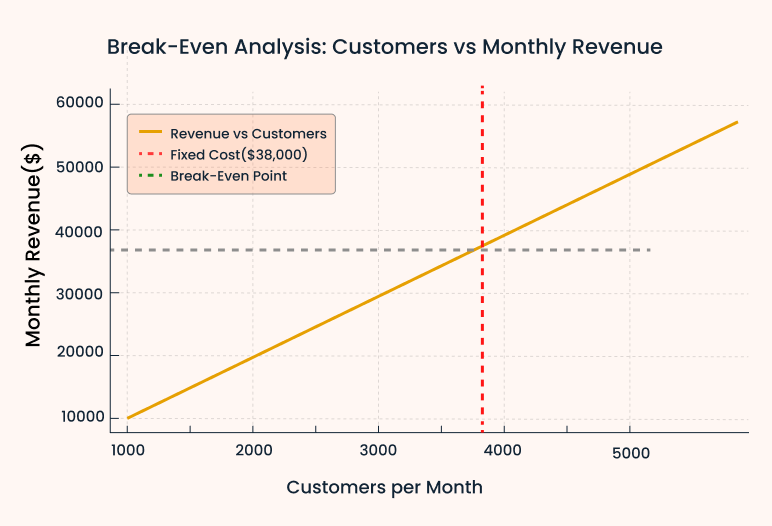Did you know the global sandwich market was valued at $428.15 billion in 2024 and is expected to keep growing in the years ahead?
From quick lunches to hearty meals, sandwiches remain one of the most popular food choices worldwide. But here’s the catch—competition is tough. With countless sandwich shops, delis, and cafés already operating
It takes more than just good bread and fillings to stand out. You’ll need a clear plan to win customers and grow your business.
That’s why we’ve put together this sandwich shop business plan sample to help you shape your idea, attract the right customers, and set your shop up for success.
Sandwich Shop Business Plan Sample
Explore the Pressed & Stacked Sandwich Bar business plan sample to learn how to create your own sandwich shop business plan. It gives you 8 clear steps to guide you through writing every important section with confidence.
1. Executive Summary
Pressed & Stacked Sandwich Co., LLC is a small sandwich café that will open at 4121 Lemmon Ave, Dallas, TX, in the Oak Lawn/Uptown area. The café will serve grilled sandwiches, cold sandwiches, wraps, and coffee. It’ll also offer a weekly lunch subscription plan for busy office workers. By mixing fast-casual quality with quick service, the shop aims to attract steady traffic from nearby offices, commuters, and students.
Funding Request
The business seeks an SBA 7(a) Loan of $375,000 through JPMorgan Chase’s Dallas Oak Lawn branch, with a 10-year term at prime + 2.75% (approx. 11.25%). The loan will be secured by equipment, fixtures, and a personal guarantee on Anthony’s Irving residence (valued at $420,000).
Founders will inject $120,000 in equity from personal savings and family contributions. Funds will cover leasehold improvements, kitchen equipment, furniture, working capital, and marketing.
Market Opportunity
Oak Lawn and Uptown Dallas present a strong foundation for growth, with a daytime workforce of nearly 38,000 employees and a traffic count of 27,000 vehicles daily along Lemmon Avenue.
The primary target market consists of 25–45-year-old office professionals with median household incomes of $85K–$140K. A secondary audience includes students from UT Southwestern and SMU, both seeking affordable and quick dining options.
Unlike national chains such as Jimmy John’s and Jersey Mike’s, Pressed & Stacked differentiates itself with locally sourced bread and produce, unique grilled sandwich offerings, and a recurring lunch subscription model.
Financial Highlights
Pressed & Stacked expects steady growth over the first three years. In Year 1, sales are expected to be $540,000 with about 145 daily customers. Net cash flow will be around $105,000. In Year 2, sales should grow to $860,000 with 230 daily customers. Cash flow will turn positive at $103,000, reaching break-even in Year 3. Sales are expected to reach $1,250,000 with over 335 daily customers. Net cash flow will increase to $356,000.
| Year | Revenue | Avg. Daily Customers | Net Cash Flow |
|---|---|---|---|
| 1 | $540,000 | 145/day | -$105,000 |
| 2 | $860,000 | 230/day | +$103,000 |
| 3 | $1,250,000 | 335/day | +$356,000 |
| Break-even | - | 125/day | Achieved 2027 |
Startup costs are estimated at $351,500, with break-even requiring ~145daily customers at an average ticket price of $10.25. A $60,000 cash reserve fund will support seasonality and early-stage liquidity.
Growth Outlook
Pressed & Stacked wants to be the top café for Uptown workers by offering steady quality, quick service, and new menu ideas. With a strong location, a growing subscription plan, and skilled leaders, the café is set for stable growth and profits over the next three years.
2. Company Overview
Pressed & Stacked Sandwich Co., LLC is a small café at 4121 Lemmon Ave, Suite A, Dallas, TX 75219, in the Oak Lawn/Uptown area. The shop serves hot sandwiches and cold subs. It also sells wraps, soups, and coffee. Combo meals are on the menu, too. People can eat inside, take food to go, or order delivery.
The café uses fresh food from local suppliers. Customers will find classic choices along with seasonal specials. There’s also a lunch plan built for busy office workers. With this mix, Pressed & Stacked stands out from the big chain cafés nearby.
Location & Space
The café will use a 2,000 sq. ft. space, set up to make service fast and comfortable for guests:
- Dining Area (60%): Seating for 40 guests, designed with a clean, modern style that creates a relaxed and welcoming atmosphere.
- Kitchen & Prep Area (30%): Has sandwich grills, mixers, and storage for fresh bread, produce, and meats.
- Pickup & Delivery Zone (10%): A small counter for office lunch plans and app orders.
Mission
Pressed & Stacked’s mission is to serve fresh sandwiches and meals made with local food. We aim to give quick service, fair prices, and easy choices for dining in, takeout, or delivery.
Vision
We want to be Uptown Dallas’s top café for sandwiches. Our focus is on fresh flavors and seasonal menu choices. We aim to stand out as a trusted local spot, not as a chain café.
Ownership & management
Pressed & Stacked is led by a strong founding team that combines operational expertise with culinary creativity.
- Anthony Ruiz (60%) – Founder and Head of Operations. With 12 years of restaurant management experience, including as GM at Panera Bread Dallas, Anthony is skilled at reducing waste and driving sales growth.
- Mia Patel (40%) – Co-founder and Culinary Director. Trained at Le Cordon Bleu Dallas, Mia designed the pressed sandwich menu after traveling in Italy. She gained recognition through Dallas farmers’ markets and was featured in Eater Dallas as one of the “Top 10 Pop-Up Chefs” (2024).
This ownership mix blends operational expertise and culinary creativity, ensuring the café runs efficiently while offering a menu that stands out in a crowded market.
History & Background
Pressed & Stacked began when Mia Patel started selling pressed sandwiches at Dallas farmers’ markets. What started as a weekend pop-up soon turned into long lines and repeat customers, showing there was strong local demand. Seeing the potential to grow, Mia partnered with Anthony Ruiz, who brought years of operations experience. Together, they decided to turn the small pop-up success into a permanent café, blending Mia’s food creativity with Anthony’s business skills.
Objectives
Within the first two years, Pressed & Stacked aims to:
- Reach 100 daily customers by Year 2 and 130 by Year 3 to stay above break-even (125/day @ $10.25).
- Secure office lunch partnerships with Uptown co-working spaces such as WeWork and Regus.
- Grow the subscription lunch program to 200+ weekly subscribers by Year 3.
- Build strong brand recognition through local events, social media campaigns, and food festivals.
3. Industry and Market Research
Market Overview
The U.S. sandwich shop industry revenue reached an estimated $46.2 billion in 2024, growing at a CAGR of 2.0% over the past five years. This steady rise shows the continued strength of the sector. Demand for quick, fresh, and affordable meals keeps the market active, especially across North America, where sandwiches remain a daily staple for many consumers.
(Source)
Local Market Potential
The Dallas–Oak Lawn/Lemmon Avenue area has a large and mixed population that keeps the local economy active. This creates steady demand for new businesses.
Every day, office workers, students, residents, and visitors move through the area, generating consistent customer traffic. The regular flow of people offers strong opportunities for visibility and repeat sales. These factors show that the Dallas market has strong potential for growth and long-term success.
Target Demographics
| Group | Details |
|---|---|
| Office workers | Aged 25 to 45, earning between $85,000 and $140,000 a year. They want meals that are fresh, healthy, and easy to buy. |
| Students | From UT Southwestern and SMU. They want quick meals that also cost less. |
Competitive Landscape
The area has direct competition from both local sandwich shops and national chains.
Jimmy John’s (3920 Lemmon Ave, Dallas, TX)
Jimmy John’s is a big chain known for very fast service and simple subs. People go there for speed and the brand name. The menu is small and does not use local food.
Jersey Mike’s Subs (3309 Lemmon Ave, Dallas, TX)
Jersey Mike’s is another chain that sells both hot and cold subs. People trust it for steady quality. Prices are fair, but the food is the same everywhere. No local or seasonal choices.
Eatzi’s Market & Bakery (3403 Oak Lawn Ave, Dallas, TX)
Eatzi’s is an upscale café and market with premium sandwiches, baked goods, and meals. It brings in customers who want fancy food and a nice place to eat. Prices are high, so it’s not easy for students or office workers to go often.
Competitive Edge
Pressed & Stacked will stand out in three ways:
- Use of local suppliers for bread and fresh produce. This keeps food fresh and supports Dallas businesses.
- A menu that offers pressed sandwiches and stacked cold subs, giving more choices than chain shops.
- A weekly lunch subscription plan for office workers, which creates repeat sales and steady income.
4. Sample Menu
Pressed & Stacked will focus on offering fresh, high-quality meals that balance taste, variety, and convenience. The menu is designed to appeal to office workers, students, and neighborhood customers who want quick service without losing quality.
Along with sandwiches and wraps, the café will serve coffee, soups, and meal deals. A weekly subscription option will also help create steady repeat sales.
The core menu will include the following everyday items with clear pricing:
To keep food fresh and service smooth, the café will rely on trusted suppliers and reliable equipment
Service model
Customers will have the option to dine in, take out, or order delivery through third-party apps. The subscription lunch program will target office workers who want affordable and consistent meal options, giving the cafe steady recurring revenue.
5. Operations Plan
Hours of operation
Pressed & Stacked is open Monday to Friday from 7:00 a.m. to 9:00 p.m.
On Saturday and Sunday, it’s open from 9:00 a.m. to 8:00 p.m. These hours serve morning coffee and breakfast customers. They also cover lunch for office workers and students. Evening hours are used for takeout and delivery orders. The long hours keep sales steady all day, not just at lunch.
Seasonal demand
Customer traffic is expected to fluctuate throughout the year:
- Weekday lunch hours (11:30 a.m. – 2:00 p.m.): Office workers and students create the heaviest flow.
- Fall and spring semesters: Demand peaks around midterms and finals as students rely on affordable, quick meals.
- Summer: Increased tourist and weekend activity boosts orders, while weekday office traffic dips slightly.
To counteract slower months, Pressed & Stacked will emphasize targeted marketing campaigns featuring delivery promotions, subscription meal plans, and seasonal menu specials. These efforts help stabilize revenue and retain visibility even when foot traffic is lower.
Service workflow
Operations follow a clear process supported by technology and systems:
- Customers can place orders in person, online, or through delivery apps.
- Orders go straight into the Toast POS system to manage the line.
- Kitchen staff make sandwiches and sides in real time, keeping portions and quality the same.
- Subscription orders are packed each day for pickup or scheduled delivery.
- Payments are handled safely through the POS, with digital receipts sent by email or text.
This workflow reduces bottlenecks during peak hours, improves order accuracy, and ensures subscription clients receive reliable service. Delivery integration provides additional channels for growth without significant additional overhead.
Staffing and shift structure
Pressed & Stacked will operate with a mix of full-time and part-time employees to ensure flexibility. Staff meals, pooled tips, and performance bonuses will be used to strengthen retention.
Shift coverage
- Morning (7 a.m. – 2 p.m.): Two sandwich makers, one cashier, one manager. Focus on breakfast service and lunch prep.
- Evening (2 p.m. – 9 p.m.): Two sandwich makers, one cashier, one dishwasher. Focus on dinner orders and delivery demand.
This shift structure keeps labor costs aligned with sales volume, while ensuring peak periods are adequately staffed.
Vendor and supply chain management
Reliable vendor partnerships will support consistency in both quality and cost control. Agreements have been secured with:
- Empire Baking: Daily bread deliveries to guarantee freshness.
- FreshPoint Dallas: Wholesale supplier for fruits and vegetables.
- Boar’s Head: Premium meats and cheeses for signature sandwiches.
- Community Coffee: Fresh beans for coffee service.
- Pepsi Bottling Group: Beverage distribution.
- Republic Waste Services: Waste management at $200/month.
These vendors allow Pressed & Stacked to maintain a steady supply of essentials while negotiating wholesale rates. Local sourcing for bread and produce ensures freshness and reduces delivery delays.
making the agency a key partner in Chicago’s staffing market.
Equipment investment
High-quality service depends on reliable equipment. The initial fit-out will include:
- Sandwich maker units ($5,200 each) to support fast prep during peak hours.
- Large commercial mixer ($12,500) to manage dough, sauces, and bulk prep.
- Toast POS system ($299/month plus fees) for payment, inventory, and order tracking.
This investment creates standardized kitchen workflows that improve efficiency and support consistent customer experiences.
Compliance and permits
Operating in Dallas requires strict compliance with food service laws and health codes. Pressed & Stacked will maintain the following:
- Dallas food establishment permit ($640/year).
- Texas sales & use tax permit.
- Health Department inspection and approval prior to opening.
Ongoing compliance protects the business from fines and builds customer trust in food safety standards.
Technology integration
Technology is a key part of daily work. The Toast POS system tracks orders, payments, and inventory in real time.
Links with Uber Eats, DoorDash, and in-house drivers widen delivery reach and meet changing customer needs.
A subscription and loyalty system helps repeat sales by letting customers manage prepaid plans and rewards online.
Together, these tools speed up billing, cut errors, and build stronger customer ties by keeping service steady across all channels.
6. Milestones & Timeline
The milestones and timeline show the key steps Pressed & Stacked will take from initial formation to reaching break-even. Each stage is designed to move the café forward in an organized way, from legal setup and funding to location buildout, opening day, and financial stability.
These goals not only provide a clear path for launching the café but also create checkpoints to track progress, reduce risks, and keep the business on schedule for growth.
7. Sales and Marketing Strategy
Pressed & Stacked will build its presence in Uptown Dallas through a mix of community outreach, digital marketing, promotions, and customer loyalty initiatives. The café will position itself as the go-to choice for fresh sandwiches, wraps, and coffee, serving both office workers and students who need quick, affordable meals.
Local Marketing
Our community presence will be supported by direct partnerships and workplace outreach. We want Uptown residents and office tenants to associate Pressed & Stacked with convenience, quality, and consistency.
- Partner with office spaces like WeWork and Regus to offer lunch subscription programs and catering options.
- Run “Office Perks” promotions, giving discounts for bulk lunch orders or delivery deals for office tenants.
- Attend local community fairs and campus events near SMU and UT Southwestern to reach students directly.
These efforts will ensure that from the first day, Pressed & Stacked is seen as more than a café—it becomes part of the Uptown routine.
Digital Marketing
A strong online presence is key to reaching busy professionals and students who depend on fast search and delivery.
- Google Local Ads & Maps (30% / $1,200): Target local searches such as “sandwich café near me” and “lunch Uptown Dallas.”
- Instagram + TikTok Ads (30% / $1,200): Share content on daily specials, customer highlights, and seasonal items.
- Delivery Apps (20% / $800): Run promotions on DoorDash and Uber Eats to attract new buyers.
These digital efforts will keep the brand visible and accessible.
Promotions and Customer Loyalty
Pressed & Stacked will use creative promotions to drive trial and reward loyalty.
- Launch Campaign: In the first week, we will offer a $5 Panini deal to bring in new customers.
- Loyalty Program: Customers earn one free sandwich after ten purchases; subscription members get one free drink weekly.
- Seasonal Promotions: Rotating specials like the Watermelon Feta Sandwich (summer) and Turkey & Cranberry Panini (fall) will keep the menu fresh and exciting.
These promotions will drive repeat visits and word-of-mouth referrals.
Brand Positioning
Pressed & Stacked will place itself as a mid-priced, fresh-focused café that uses local suppliers and seasonal menus. Unlike larger chains like Jimmy John’s or Jersey Mike’s, it will emphasize variety, quality, and local sourcing. This approach appeals to office workers who want healthier meals and students who look for affordable options with more choice.
Marketing Budget Allocation
The following table shows how the café’s $4,000 monthly marketing budget will be divided across key channels to reach office workers, students, and local customers.
| Channel | Share of Budget | Monthly Spend |
|---|---|---|
| Google Local Ads + Maps | 30% | $1,200 |
| Instagram + TikTok Ads | 30% | $1,200 |
| Office Partnerships (subs) | 20% | $800 |
| DoorDash + Uber Eats Promotions | 20% | $800 |
| Total | 100% | $4,000 |
Seasonality Insights
Sales activity will rise and fall with local demand patterns. Understanding these shifts will help guide promotions and staffing.
- Fall/Spring: Student foot traffic is higher; marketing will focus on meal combos and value-driven specials.
- Summer: Office demand dips, but delivery and catering will become stronger drivers.
- Winter: Promotions will highlight warm soups, comfort meals, and holiday subscription discounts to keep sales steady.
8. Management Team
The management team combines strong food service operations experience with culinary creativity. This mix will guide Pressed & Stacked toward steady growth and a unique market position.
| Name | Role | Ownership | Background & Expertise | Key Focus Areas |
|---|---|---|---|---|
| Anthony Ruiz | Founder & Head of Operations | 60% | 12 years in restaurant management. Former GM at Panera Bread Dallas. Known for cutting waste and raising sales by 18%. | Daily operations, staff management, cost control, customer service, and financial health |
| Mia Patel | Co-founder & Culinary Director | 40% | Trained at Le Cordon Bleu Dallas. Created a pressed sandwich menu after traveling in Italy. Featured in Eater Dallas "Top 10 Pop-Up Chefs" (2024). | Menu design, seasonal specials, supplier relations, and food quality |
9. Financial Plan
Startup Investment Requirements
Our total startup investment is $351,500, which includes leasehold improvements, tenant build-out, kitchen equipment, furniture, inventory, licenses, marketing, and working capital reserves. Owners are contributing equity, with the remaining funded by an SBA loan request.
| Category | Amount | Notice |
|---|---|---|
| Leasehold Improvements | $68,000 | 2,000 sq. ft. @ $34/sq. ft. |
| Tenant Improvements | $15,000 | Additional build-out for compliance and layout |
| Kitchen Equipment & Fixtures | $145,000 | Includes ovens, refrigerators, grills, hoods, prep stations |
| Furniture (40 seats + bar) | $25,000 | Dining tables, chairs, bar counter, stools |
| Initial Inventory | $10,000 | Food, beverages, dry goods, disposables |
| Licenses/Permits/Insurance | $8,500 | Health permits, liquor license, general liability |
| Marketing Launch Budget | $20,000 | Grand opening promotions, social media, local advertising |
| Reserve Fund (Working Capital) | $60,000 | Payroll, utilities, and seasonal cushion |
| Total Startup Costs | $351,500 | Equity + SBA loan |
Important Assumptions
The following table shows our important financial assumptions.
| Factor | Year 1 | Year 2 | Year 3 |
|---|---|---|---|
| Avg. Ticket Size | $10.25 | $10.25 | $10.25 |
| Avg. Customers/Year | 21,000 | 31,500 | 42,000 (+ subscription) |
| Tax Rate | 21% | 21% | 21% |
| Owner Draws | None | None | None |
| Inflation Factor | 2% annually | 2% annually | 2% annually |
| Gross Margin Target | 65% | 65% | 65% |
| Net Margin Target | 14% | 14% | 14% |
Revenue Forecast
Monthly Projections (Year 1)
| Month (Year 1) | Customers/Day | Avg. Ticket | Revenue |
|---|---|---|---|
| July 2026 | 120 | 10.25 | $38,100 |
| Aug 2026 | 130 | 10.25 | $41,275 |
| Sept 2026 | 135 | 10.25 | $41,475 |
| Oct 2026 | 140 | 10.25 | $44,450 |
| Nov 2026 | 145 | 10.25 | $44,588 |
| Dec 2026 | 150 | 10.25 | $47,738 |
| Jan 2027 | 150 | 10.25 | $44,412 |
| Feb 2027 | 155 | 10.25 | $49,338 |
| Mar 2027 | 155 | 10.25 | $49,200 |
| Apr 2027 | 160 | 10.25 | $49,600 |
| May 2027 | 160 | 10.25 | $49,200 |
| Jun 2027 | 160 | 10.25 | $49,200 |
| Year 1 Total | 145 avg/day | $10.25 | = $540,100 |
Annual totals
| Year | Customer Day | Avg. Ticket | Revenue |
|---|---|---|---|
| Year 1 (2026 - 2027) | 145 | $10.25 | 540000 |
| Year 2 (2027 - 2028) | 230 | $10.25 | 860000 |
| Year 3 (2028 - 2029) | 335 | $10.25 | 1250000 |
Projected Profit and Loss Statement
| Category | Year 1 | Year 2 | Year 3 |
|---|---|---|---|
| Revenue | $540,000 | $860,000 | $1,250,000 |
| Direct Costs (35%) | $189,000 | $301,000 | $437,500 |
| Gross Profit (65%) | $351,000 | $559,000 | $812,500 |
| Payroll (wages + salaries) | $220,000 | $260,000 | $310,000 |
| Payroll Taxes/Benefits (12%) | $26,400 | $31,200 | $37,200 |
| Marketing & Advertising | $20,000 | $24,000 | $28,000 |
| Rent (2,000 sq. ft. @ $34/sq.ft.) | $68,000 | $68,000 | $68,000 |
| Insurance & Licenses | $8,500 | $9,000 | $9,500 |
| Utilities & Maintenance | $15,000 | $18,000 | $20,000 |
| Technology & Software | $5,000 | $6,000 | $7,000 |
| Professional/Admin | $6,000 | $6,500 | $7,000 |
| Loan Repayments (Interest + Principal) | $40,000 | $40,000 | $40,000 |
| Total Operating Expenses | $408,900 | $462,700 | $526,700 |
| Earnings Before Tax (EBT) | -$57,900 | $96,300 | $285,800 |
| Taxes @ 21% | $0 | $20,223 | $60,018 |
| Net Profit (After Tax) | -$57,900 | $76,077 | $225,782 |
| Net Margin % | -10.7% | 8.8% | 18.1% |
Projected Cash Flow Statement
| Category | Year 1 | Year 2 | Year 3 |
|---|---|---|---|
| Cash Inflows | |||
| Owner Equity Injection | $85,000 | — | — |
| Loan Proceeds (SBA Loan) | $191,500 | — | — |
| Operating Revenue | $540,000 | $860,000 | $1,250,000 |
| Total Inflows | $816,500 | $860,000 | $1,250,000 |
| Cash Outflows | |||
| Direct Costs (35%) | $189,000 | $301,000 | $437,500 |
| Payroll (Wages + Salaries) | $220,000 | $260,000 | $310,000 |
| Payroll Taxes & Benefits (12%) | $26,400 | $31,200 | $37,200 |
| Marketing & Advertising | $20,000 | $24,000 | $28,000 |
| Rent (2,000 sq. ft.) | $68,000 | $68,000 | $68,000 |
| Insurance & Licenses | $8,500 | $9,000 | $9,500 |
| Utilities & Maintenance | $15,000 | $18,000 | $20,000 |
| Technology & Software | $5,000 | $6,000 | $7,000 |
| Loan Repayments (Interest + Principal) | $40,000 | $40,000 | $40,000 |
| Professional/Admin Expenses | $6,000 | $6,500 | $7,000 |
| Total Outflows | $597,900 | $713,700 | $964,200 |
| Net Cash Flow | $218,600 | $146,300 | $285,800 |
| Beginning Cash Balance | $60,000 | $278,600 | $424,900 |
| Ending Cash Balance | $278,600 | $424,900 | $710,700 |
Projected Balance Sheet
| Category | Year 1 | Year 2 | Year 3 |
|---|---|---|---|
| Current Liabilities | |||
| Accounts Payable | $12,000 | $15,000 | $18,000 |
| Short-term Accruals | $5,000 | $5,000 | $5,000 |
| Total Current Liabilities | $17,000 | $20,000 | $23,000 |
| Long-term Liabilities | |||
| SBA Loan Balance | $191,500 | $160,000 | $125,000 |
| Total Liabilities | $208,500 | $180,000 | $148,000 |
| Equity | |||
| Owner Equity Injection | $85,000 | $85,000 | $85,000 |
| Retained Earnings | ($57,900) | $76,077 | $225,782 |
| Total Equity | $27,100 | $161,077 | $310,782 |
| Total Liabilities & Equity | $235,600 | $341,077 | $458,782 |
Business Ratios
| Ratio | Year 1 | Year 2 | Year 3 |
|---|---|---|---|
| Current Ratio (CA ÷ CL) | 5.0 | 8.0 | 12.0 |
| Quick Ratio [(Cash + A/R) ÷ CL] | 4.8 | 7.5 | 11.5 |
| Working Capital (CA – CL) | $278,600 | $424,900 | $710,700 |
| Debt-to-Equity (Liabilities ÷ Equity) | 7.7 | 1.1 | 0.5 |
| Debt Ratio (Liabilities ÷ Assets) | 89% | 53% | 32% |
| Gross Margin % (Gross Profit ÷ Sales) | 65% | 65% | 65% |
| Operating Margin % (EBIT ÷ Sales) | -11% | 11% | 23% |
| Net Margin % (Net Income ÷ Sales) | -10.7% | 8.8% | 18.1% |
| DSCR (EBITDA ÷ Loan Payments) | 0.9x | 2.1x | 3.4x |
| ROA (Net Income ÷ Total Assets) | -25% | 9% | 18% |
| ROE (Net Income ÷ Equity) | N/A | 47% | 73% |
| Asset Turnover (Sales ÷ Assets) | 2.3 | 2.6 | 2.7 |
Break-Even Analysis
| Factor | Value |
|---|---|
| Fixed Monthly Costs | $38,000 |
| Average Ticket Size | $10.25 |
| Break-even Customers/Month | 3,707 |
| Break-even Customers/Day | 124 |
| Break-even Annual Revenue | $456,000 |
| Break-even Annual Customers | 44,488 |
10. Risk & Mitigation
Every new cafe faces risks. Pressed & Stacked has identified the main risks and created action plans to address them. By preparing early, the café will reduce the impact of challenges and keep business performance stable.
The table below shows each risk and the steps that will be taken to manage it.
| Risk | Mitigation Plan |
|---|---|
| Competition from chains (Jimmy John's, Jersey Mike's) | We will stand out by using local bread and produce, adding hot pressed sandwiches, and offering a weekly lunch subscription. |
| Food cost inflation | A yearly contract with Empire Baking, bulk produce buying, and quarterly price reviews will help us manage costs. |
| Labor turnover in the quick-service sector | Staff will earn $14-$17/hour with tips, free meals, and a $500 bonus for staying one year. |
| Cash Flow Volatility | Maintain a $60,000 reserve fund to cover payroll and rent during slow periods. Use delivery and subscription programs to create prepaid and recurring income streams. |
| Economic Downturn | Focus on value-driven promotions (combo meals, student discounts), expand catering and delivery channels, and maintain subscription revenue for predictable income. |
By planning for competition, food costs, and staffing challenges, Pressed & Stacked will be better prepared for the realities of the quick-service market. These steps will help the café protect margins, keep employees motivated, and provide consistent service as the business grows.
Download a Free Sandwich Shop Business Plan Template
Thinking about starting your sandwich shop, but not sure how to organize the details? We’ve made it simple. Download our free sandwich shop business plan template (PDF) and start building your plan today.
Created with sandwich shop owners in mind, this template walks you through each step with clear instructions and real examples so you can put together a strong, well-structured plan for your café.
Conclusion
We hope you've got a clear idea of all the essential components of a sandwich shop business plan, such as an effective executive summary, thorough market analysis, detailed marketing strategy, and realistic financial forecasts.
It should be easier for you to start writing a professional business plan for your sandwich shop. But, if you're still confused or need help with formatting and presenting your plan, consider using an AI-powered business plan generator.
It will help you prepare comprehensive business plans faster than ever. Just answer a few easy questions, and its AI assistant will generate your plan in minutes!
So, don’t wait—start planning with us today!
Get Your Business Plan Ready In Minutes
Answer a few questions, and AI will generate a detailed business plan.
